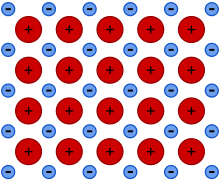
Back رابطة فلزية Arabic Enllaz metálicu AST Metal rabitəsi AZ Метална връзка Bulgarian ধাতব বন্ধন Bengali/Bangla Metalna veza BS Enllaç metàl·lic Catalan Gĭng-sṳ̆k-giông CDO بەندی کانزایی CKB Kovová vazba Czech
This article is written like a personal reflection, personal essay, or argumentative essay that states a Wikipedia editor's personal feelings or presents an original argument about a topic. (February 2021) |

| Types of radii |
|---|
Metallic bonding is a type of chemical bonding that arises from the electrostatic attractive force between conduction electrons (in the form of an electron cloud of delocalized electrons) and positively charged metal ions. It may be described as the sharing of free electrons among a structure of positively charged ions (cations). Metallic bonding accounts for many physical properties of metals, such as strength, ductility, thermal and electrical resistivity and conductivity, opacity, and lustre.[1][2][3][4]
Metallic bonding is not the only type of chemical bonding a metal can exhibit, even as a pure substance. For example, elemental gallium consists of covalently-bound pairs of atoms in both liquid and solid-state—these pairs form a crystal structure with metallic bonding between them. Another example of a metal–metal covalent bond is the mercurous ion (Hg2+
2).
- ^ Metallic bonding. chemguide.co.uk
- ^ Metal structures. chemguide.co.uk
- ^ Chemical Bonds. chemguide.co.uk
- ^ "Physics 133 Lecture Notes" Spring, 2004. Marion Campus. physics.ohio-state.edu